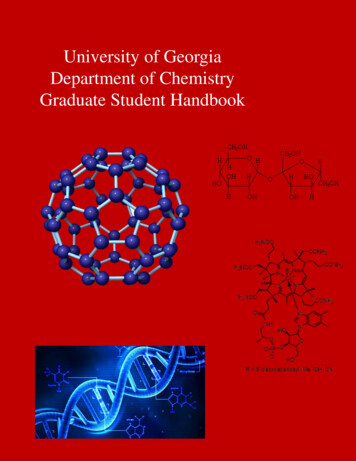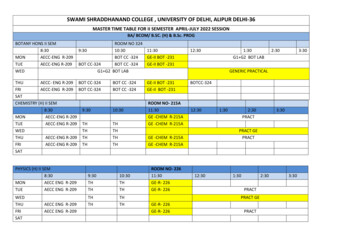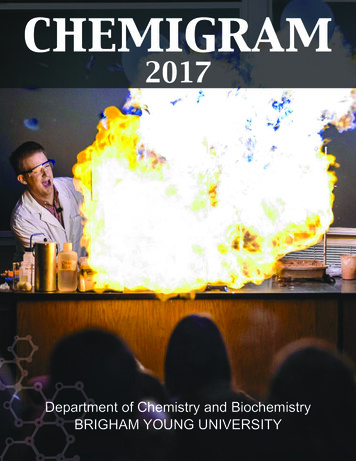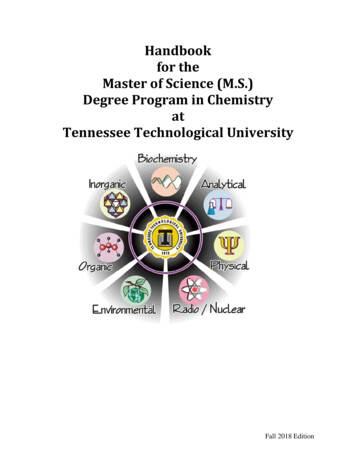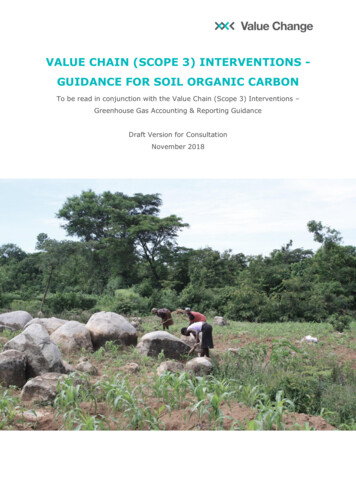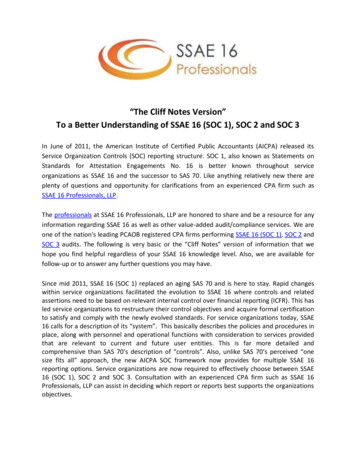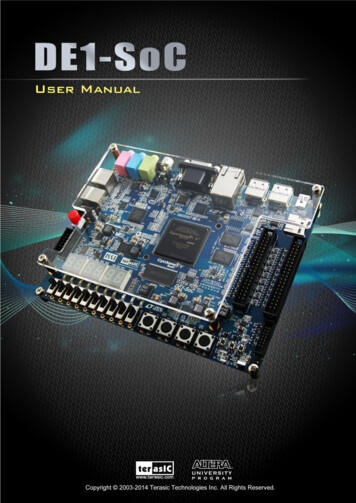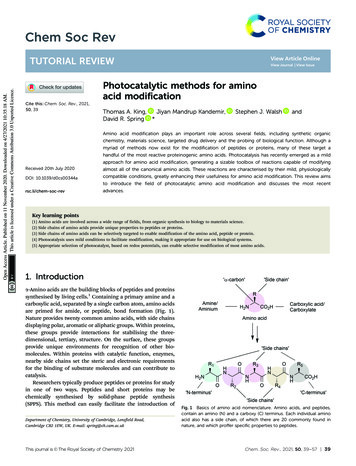
Transcription
Chem Soc RevView Article OnlineOpen Access Article. Published on 11 November 2020. Downloaded on 4/27/2021 10:35:18 AM.This article is licensed under a Creative Commons Attribution 3.0 Unported Licence.TUTORIAL REVIEWCite this: Chem. Soc. Rev., 2021,50, 39View Journal View IssuePhotocatalytic methods for aminoacid modificationThomas A. King,Jiyan Mandrup Kandemir,David R. Spring *Stephen J. WalshandAmino acid modification plays an important role across several fields, including synthetic organicchemistry, materials science, targeted drug delivery and the probing of biological function. Although amyriad of methods now exist for the modification of peptides or proteins, many of these target ahandful of the most reactive proteinogenic amino acids. Photocatalysis has recently emerged as a mildapproach for amino acid modification, generating a sizable toolbox of reactions capable of modifyingReceived 20th July 2020almost all of the canonical amino acids. These reactions are characterised by their mild, physiologicallyDOI: 10.1039/d0cs00344acompatible conditions, greatly enhancing their usefulness for amino acid modification. This review aimsto introduce the field of photocatalytic amino acid modification and discusses the most recentrsc.li/chem-soc-revadvances.Key learning points(1)(2)(3)(4)(5)Amino acids are involved across a wide range of fields, from organic synthesis to biology to materials science.Side chains of amino acids provide unique properties to peptides or proteins.Side chains of amino acids can be selectively targeted to enable modification of the amino acid, peptide or protein.Photocatalysis uses mild conditions to facilitate modification, making it appropriate for use on biological systems.Appropriate selection of photocatalyst, based on redox potentials, can enable selective modification of most amino acids.1. Introductiona-Amino acids are the building blocks of peptides and proteinssynthesised by living cells.1 Containing a primary amine and acarboxylic acid, separated by a single carbon atom, amino acidsare primed for amide, or peptide, bond formation (Fig. 1).Nature provides twenty common amino acids, with side chainsdisplaying polar, aromatic or aliphatic groups. Within proteins,these groups provide interactions for stabilising the threedimensional, tertiary, structure. On the surface, these groupsprovide unique environments for recognition of other biomolecules. Within proteins with catalytic function, enzymes,nearby side chains set the steric and electronic requirementsfor the binding of substrate molecules and can contribute tocatalysis.Researchers typically produce peptides or proteins for studyin one of two ways. Peptides and short proteins may bechemically synthesised by solid-phase peptide synthesis(SPPS). This method can easily facilitate the introduction ofDepartment of Chemistry, University of Cambridge, Lensfield Road,Cambridge CB2 1EW, UK. E-mail: spring@ch.cam.ac.ukThis journal is The Royal Society of Chemistry 2021Fig. 1 Basics of amino acid nomenclature. Amino acids, and peptides,contain an amino (N) and a carboxy (C) terminus. Each individual aminoacid also has a side chain, of which there are 20 commonly found innature, and which proffer specific properties to peptides.Chem. Soc. Rev., 2021, 50, 39--57 39
View Article OnlineOpen Access Article. Published on 11 November 2020. Downloaded on 4/27/2021 10:35:18 AM.This article is licensed under a Creative Commons Attribution 3.0 Unported Licence.Tutorial ReviewChem Soc Revnon-canonical amino acids (ncAAs), and while this was previously limited to peptides of less than 50 AA, recent developments have drastically increased that limit.2 Alternatively,larger peptides and proteins may be produced by in vitrocellular expression, by introduction of the encoding DNAsequence into the expression host. While large proteins aremore easily produced using this method, introduction of ncAAsin vitro requires the use of codon-suppression technology andaddition of the ncAA to the cell suspension.3Amino acid modification is relevant across multiple fields(Fig. 2). In nature itself, many amino acid residues have posttranslational modifications (PTMs); phosphate groups, acetylgroups, sulfonate groups and methyl groups are all known to beadded to amino acid side chains after the translation of anmRNA strand into a peptide to transiently control their activityand increase the structural diversity available from just 20available building blocks.4 Mimicking these modificationscan help researchers study their effects. Beyond simple PTMs,a range of other chemical moieties have been artificially addedto peptides or proteins.5 For instance, addition of chemicalmoieties (e.g. fluorophores) to proteins of interest can aid inthe elucidation of cellular processes (e.g. subcellular proteinlocalisation). Alternatively, addition of a cytotoxic or modulatory drug to a targeting protein (e.g. a tumour-specific antibody)can produce a biotherapeutic with superior efficacy andtolerability compared to chemotherapy.6 As readily availablechiral reagents, a-amino acids are used extensively in syntheticorganic chemistry. Therefore, methods for the modification ofthe common 20 amino acids enhances their usefulness asbuilding blocks. Beyond this, biocatalytic transformations arenow widespread in organic synthesis. While separation of anenzyme from a reaction mixture can be challenging, modification of the enzyme such that it is attached to a solid support(at a residue which is not significant for enzyme activity),purification can be greatly simplified. Finally, the use ofbiomolecules in the development of materials is garneringincreased interest.7The modification of an amino acid greatly expands its utilityin chemical synthesis. Many synthetic strategies rely onnaturally occurring chirality to control the stereoselectivity ofThomas King received his Mastersdegree from the University ofCambridge in 2018, during whichhe conducted research in the groupof Professor David Spring in thefield of diversity-oriented synthesis.He began his PhD in the samegroup later that year. His currentresearch focus is on the use ofphotoredox catalysis for aminoacid modification.Jiyan Mandrup Kandemir receivedhis MSc in Medicinal ChemistryfromtheUniversityofCopenhagen in 2019, havingworked on the synthesis andevaluation of HDAC inhibitors inthe laboratory of ProfessorChristian Adam Olsen. He iscurrently a PhD student in thelaboratory of Professor DavidSpring at the University ofCambridge, where his currentresearch focuses on the use ofphotoredox catalysis for themodification of amino acids.Thomas A. KingJiyan Mandrup KandemirStephen Walsh received his PhDin 2019 from the University ofCambridge, where he worked onbioconjugationmethodologydevelopment in the laboratory ofProfessor David Spring. He iscurrently a postdoctoral researchassociate in the same group,where his work involves thedevelopmentofnewbiotherapeutic modalities.Stephen J. Walsh40 Chem. Soc. Rev., 2021, 50, 39--57David R. SpringDavid Spring is currentlyProfessor of Chemistry andChemicalBiologyattheUniversity of Cambridge withinthe Chemistry Department. Hereceived his DPhil (1998) atOxford University under Sir JackBaldwin. He then worked as aWellcome Trust PostdoctoralFellow at Harvard Universitywith Stuart Schreiber (1999–2001), after which he joined thefaculty at the University of Cambridge. His research programmeis focused on the use of chemistryto explore biology.This journal is The Royal Society of Chemistry 2021
View Article OnlineOpen Access Article. Published on 11 November 2020. Downloaded on 4/27/2021 10:35:18 AM.This article is licensed under a Creative Commons Attribution 3.0 Unported Licence.Chem Soc RevFig. 2 Routes to, and applications of, amino acid and peptide modification.Amino acids and their derivatives can be used in chemical synthesis as chiralreagents or building blocks to control or install stereochemistry. Amino acidscan also be used to generate modified peptides via two distinct routes.Modification can be either made to an individual amino acid which is thenincorporated during peptide synthesis (route 1) or achieved site-selectivelyafter peptide synthesis (route 2). Modification of peptides can aid discoveryacross a wide variety of fields.reactions, either using chiral catalysts (reagent control), orthrough the influence of chiral centres within the substrate(substrate control). a-Amino acids constitute a significantportion of the so-called ‘chiral pool’ used by researchers to thisend. There are 20 commonly available amino acids, whichcan provide unique functionality within a synthesis, eitherthrough incorporation into the substrate, or for the generationof catalysts. Methods for modifying an amino acid withoutepimerisation of the chiral centre would enable the generationof a far wider selection of reagents, thereby deepening thechiral pool. These alternative amino acids can also be used inpeptide or protein synthesis as ncAAs.The modification of an amino acid within a peptide orprotein through the addition of a chemical moiety is commonlyknown as bioconjugation. Bioconjugation is also used moregenerally to describe the chemical addition of a moiety to anyThis journal is The Royal Society of Chemistry 2021Tutorial Reviewbiological molecule. It has long been established that theseadded moieties can have a profound impact on the behaviourof the biomolecule of interest.Any bioconjugation reaction must consider the implicationsof the chemistry on the substrate. Peptides and proteins aretypically folded into an intricate secondary and often tertiarystructure, formed in their native cellular environment. This canbe disrupted by reagents (such as ureas), pH fluctuation, orheat, leading to a breakdown of structure and consequentlyfunction.1 Therefore, bioconjugation protocols must utiliseexceptionally mild reaction conditions to maintain the structureof the biomolecule. Additionally, many peptides or proteins useparticular side chains or groups of side chains to carry out theirfunction. The purpose of the modification must therefore becarefully considered; to block or inhibit function throughmodification, an amino acid side chain which is required foractivity should be targeted. Conversely, if retained function isdesired, modification distal to the functional site or domainshould be undertaken. An ‘ideal’ bioconjugation strategy cantherefore be said to involve: Site-selectivity (chemo- and regioselective) Compatibility with physiological conditions (ca. 37 1C,aqueous solvent, neutral pH) Fast reaction kinetics Minimal, non-toxic by-productsUsing traditional chemistry, the vast majority of bioconjugation tools have made use of the nucleophilicity of a handful ofamino acid side chains, particularly lysine or cysteine, to installthe modification.8 An alternative strategy which has beenwidely used in protein or peptide modification is the incorporation of non-canonical amino acids with side chains thatcontain bioorthogonally reactive functional groups (e.g. azides,ketones).9 These groups are then amenable to selective modification with the desired payload containing a complementaryreactive handle. While effective, these strategies require geneticcode expansion for ribosomal installation in a growing peptidechain and/or chemical synthesis of the complex ncAAs. In recentyears, transition metal catalysis has also been applied to themodification of amino acids, peptides and proteins.10Photocatalysis has recently emerged as a mild method foramino acid modification.11 Prominent in the attractive attributes of photocatalysis are the mild conditions often requiredand the potential modification of residues with otherwiseinert side chains. Through photocatalysis, radical generationis simplified greatly – the need for high energy reagents orinitiators, which are commonly required in traditional radicalprocesses, is eliminated. Furthermore, visible-light-mediatedmethods for radical generation can typically be achieved atambient temperature. For amino acid modification, these mildconditions reduce the chance of epimerisation of the a-carbon.While some photoredox-catalysed methods are only suitable forindividual amino acid modification, the mild conditions canalso allow for application of the chemistry to peptides, or evenproteins.This tutorial review provides an introduction to photoredoxcatalysis for amino acid modification, both individually andChem. Soc. Rev., 2021, 50, 39--57 41
View Article OnlineOpen Access Article. Published on 11 November 2020. Downloaded on 4/27/2021 10:35:18 AM.This article is licensed under a Creative Commons Attribution 3.0 Unported Licence.Tutorial Reviewwithin larger peptide sequences. The underlying principles ofphotoredox catalysis are described, followed by implications foramino acid modification. For each amino acid, a brief history ofits photocatalytic modification is provided, along with the mostrecent advances. Of particular note is the recent development ofC–H functionalisation methods, which have enabled modification of amino acids for which there are currently limitedalternatives. For discussions of other amino acid modificationstrategies please refer to other reviews of the field.8,12–162. Photoredox catalysisThe advent of visible-light photosensitisers has re-energisedresearch into light-mediated transformations. Light has beenused in chemistry for decades, for example to promote bondcleavage (e.g. initiators such as azobisisobutyronitrile (AIBN)) orenable thermally-prohibited transformations by promotingalkenes to their excited states (e.g. cycloadditions/pericyclicreactions). However, with the discovery of molecules which interact with visible light came the realisation that they can act asmediators for a plethora of chemical transformations. Usingvisible light, a photosensitiser (or photocatalyst) and a substratewith an appropriately matched redox potential, radical species canbe generated under remarkably mild conditions, and subsequently harnessed to achieve chemical transformations.17,18The photocatalytic cycle for most photochemical processesdiscussed here involves electron transfer between excitedChem Soc Revcatalyst and substrate, although energy transfer is also possible.19Photoredox catalysis begins with the electronic excitation ofan organic or inorganic compound (PC), through absorption oflight (Fig. 3). These excited state molecules (PC*) then undergoquenching, typically through single electron transfer (SET),resulting in oxidation (blue) or reduction (red) of a substrate.The substrate is consequently activated for bond cleavage,atom abstraction, or nucleophilic or electrophilic attack. Afterquenching, the oxidised or reduced catalyst (PCox or PCred)regains, or loses, an electron to return to the starting groundstate catalyst (PC).In developing a photocatalytic protocol, several key properties of the catalyst must be considered: redox potential, excitedstate lifetime, absorption maximum, and solubility. If oxidationof the substrate is desired, a photocatalyst which has an excitedstate reduction potential above that of the substrate is required.Conversely, if reduction is desired, the reverse is true. Photocatalysts have been discovered or developed, with a wide rangeof excited state and ground state redox potentials (most withinca. 2 V vs. the standard hydrogen electrode, SHE), thusenabling selection of the most appropriate catalyst for a chosensubstrate. Significantly, the lifetime of the excited state of thecatalyst before spontaneous return to the ground state variesgreatly across catalysts. Catalysts with longer lifetimes allow fora greater probability of reaction, as the probability of thereactive catalyst species associating with substrate moleculesincreases with increased excited state lifetime. Transitionmetal-based catalysts tend to have longer excited state lifetimesFig. 3 Visible-light-mediated activation of a photoredox catalyst: upon absorption of light of an appropriate wavelength, the photocatalyst (PC)becomes excited (usually denoted by an asterisk), with one of its electrons promoted to a higher energy orbital. This excited state is activated for electron(or energy) transfer. Substrates with a higher redox potential can accept an electron from the excited catalyst (red); substrates with a lower redoxpotential can lose an electron to the excited catalyst (blue). In this way, organic radicals are formed on the substrates, which can then undergo furtherreaction. Subsequently, electrons are returned to, or taken from, the intermediate catalyst species to regenerate the ground state (GS) catalyst and closethe catalytic cycle. Bpy 2,2 0 -bipyridyl.42 Chem. Soc. Rev., 2021, 50, 39--57This journal is The Royal Society of Chemistry 2021
View Article OnlineOpen Access Article. Published on 11 November 2020. Downloaded on 4/27/2021 10:35:18 AM.This article is licensed under a Creative Commons Attribution 3.0 Unported Licence.Chem Soc RevTutorial Reviewthan purely organic photocatalysts (ms compared to ns). Finally,the wavelength at which the catalyst absorbs is also important.Matching the light source with the absorption maximum ofthe catalyst will greatly increase the proportion of catalystmolecules in the excited state, thereby increasing the rate ofreaction. Most commonly used photocatalysts absorb in theblue region of the visible spectrum, although new catalysts arebeing developed which can absorb longer wavelength redlight.20 Redox potentials, excited state lifetimes, and absorptionmaxima for commonly used photocatalysts are readilyavailable.17,18Practically, photocatalysis is simple to perform. After carefulselection of an appropriate catalyst, a light source must beacquired. Despite calls for standardisation in recent years,21most published reports detail the use of ‘shop-bought’ LEDlight sources. Provided the absorption maximum of yourcatalyst lies within the emitted wavelength of your source, anylight should provide results. However, while household iridescent lightbulbs can provide the required photons, they oftenalso emit large quantities of heat. LEDs, on the other hand,offer irradiation without excessive heating. Despite this, overtime, minimal heating from the light source can significantlyraise the reaction temperature. For this reason, a fan is oftenused to maintain constant reaction conditions.3. Photocatalytic amino acidmodificationMany side chains of amino acids, particularly those withheteroatoms, have appropriate oxidation potentials for quenching excited state photocatalysts. With careful control of oxidation potentials via selection of an appropriate catalyst, selectiveoxidation or reduction of, and therefore radical generation at,amino acid residues can be performed. These radicals canthen be coupled, generally with electrophiles or other radicals,to install the desired modification.Recent years have witnessed a significant increase in thenumber of photocatalytic methods being reported. While themajority of these do not focus solely on amino acid modification,several document investigations on amino acid or peptidesubstrates to showcase the utility of the methodology. In thefollowing sections, advances aimed specifically at amino acid orpeptide modification, and those that demonstrate applicability tothese, will be discussed. To aid the reader in understandingthe application of each method, a colour code will be used.Procedures used in modification of individual amino acids willbe marked red, those demonstrated on peptide substrates will bemarked blue, and those demonstrated on protein substrates willbe marked green.Polar amino acid side chainsPolar amino acids (see Fig. 4), most notably cysteine and lysine,have received great interest from the scientific community in thedevelopment of ionic methods for amino acid modification.8This journal is The Royal Society of Chemistry 2021Fig. 4 Amino acids containing polar side chains, or whose photochemicalactivity involves the presence of heteroatoms.However, they are also amenable to modification via radicalprocesses, and have thus been targeted through photocatalysis.Cysteine. Cysteine residues are commonly modified usingionic pathways, by addition to electrophiles such as maleimidesor other conjugate acceptors.8 However, photocatalytic methodshave been developed which expand the range of transformationsthat can be made.Thiol–ene reactions, commonly achieved using chemicalradical initiators or ultraviolet (UV) light, can also be achievedusing visible light photocatalysis. In 2017, Wang and co-workersused allyl alcohols and amides as reagents for cysteine and thiosugar modification (Fig. 5).22 An excited acridinium catalyst wasused as the necessary oxidising agent, generating the thiyl radicalafter deprotonation. The alkene could then be attacked, andthe product generated after a final hydrogen atom abstraction,possibly from unreacted thiol, thereby generating additional thiylradical. Testing the reaction scope with benzyl mercaptan, allylesters, amides, alcohols and silanes were shown to be competentcoupling partners after irradiation for 6 hours (76–87%). Althoughfew examples using cysteine were presented, those couplings werealso achieved in high yields (75–90%), attaching a sugar, nucleicacid, or peptide to the residue. Of particular interest was thetreatment of cysteine with the allyl ester of aspartic acid, which gavethe cross-linked amino acids in high yield (85%), suggesting thepotential utility of this methodology for peptide macrocyclisation.In 2018, Molander and co-workers developed a method forcysteine arylation using a ruthenium photocatalyst, nickelChem. Soc. Rev., 2021, 50, 39--57 43
View Article OnlineOpen Access Article. Published on 11 November 2020. Downloaded on 4/27/2021 10:35:18 AM.This article is licensed under a Creative Commons Attribution 3.0 Unported Licence.Tutorial ReviewChem Soc RevFig. 5 Thiol–ene reaction of cysteine. Using an acridinium catalyst togenerate the thiyl radical, cysteine undergoes alkene addition. The resultant secondary radical persists for long enough for hydrogen atom transfer(HAT) to occur to generate the modification product. Acr. 9-mesityl-10methylacridinium.co-catalyst and a silicate-based hydrogen atom transfer reagent(Fig. 6).23 After excitation of the photocatalyst, oxidation of thesilicate leads to the homolytic cleavage of the C–Si bond toproduce a carbon-centred radical. This was able to abstract theproton from the cysteine thiol, generating a thiyl radical.Trapping of the thiyl radical with the nickel(0) species was thenfollowed by oxidative addition of an aryl halide. Finally, reductive elimination from the nickel(III) complex produced theC(sp2)–S bond. The aryl substrate scope and amino acid compatibility was explored using glutathione (GSH) as substrate.Substituents on the aryl bromide greatly influenced the successof the reaction, as yields ranged from 14% (with a para-alcohol)to 83% (using 4-bromobenzyl boronic acid). Aryl bromidescontaining nitrile, halide, amide, sulfonamide, ether, alcohol,and carboxylate groups were all successful coupling partners.44 Chem. Soc. Rev., 2021, 50, 39--57Fig. 6 Cysteine arylation using dual nickel–ruthenium catalysis. A silicatereagent was proposed to generate the thiyl radical required in the nickelcatalytic cycle through hydrogen atom transfer (HAT). Dtbbpy 4,4 0 -ditert-butyl-2,2 0 -bipyridyl. Bpy 2,2 0 -bipyridyl.Disappointingly, a pendant azide group was not tolerated onthe aryl bromide. Aryl bromide-containing chemical linkers,biologic probes and drug molecules were all used for themodification, producing GS-aryl conjugates in moderate togood yields (35–83%). The method was also successfully appliedto the modification of a polypeptide (9 amino acids (AAs)) using4-bromobenzonitrile (complete conversion was observed). Carboxylate functionality and aromatic amino acids were shown not tointerfere with the reaction, whereas the presence of lysine, prolineand arginine significantly hindered reactivity.This journal is The Royal Society of Chemistry 2021
View Article OnlineOpen Access Article. Published on 11 November 2020. Downloaded on 4/27/2021 10:35:18 AM.This article is licensed under a Creative Commons Attribution 3.0 Unported Licence.Chem Soc RevTutorial ReviewFig. 7 Ligand directed modification of cysteine on a protein surface.Using methodology similar to that used on tyrosine by Nakamura (videinfra), Wilson and co-workers were able to selectively label cysteine on theMCL-1 protein.Bon, Wilson and co-workers recently demonstrated a liganddirected approach to the selective labelling of a native cysteinecontaining protein, and current anticancer target, human MCL-1(Fig. 7).24 By appending a ruthenium photocatalyst to an oligopeptide (19 AAs) known to bind the target protein, the groupwere able to selectively oxidise and therefore modify a proximalcysteine residue (Cys286) on MCL-1 after irradiation with visiblelight. The thiyl radical formed after cysteine oxidation wastrapped with aniline-based reagents similar to those used inprevious work by Nakamura and co-workers for photocatalytictyrosine modification (vide infra). While significant conversionwas observed, increased irradiation time led to the generation ofby-products, presumed to be due to oxidation of the MCL-1protein by the photocatalyst. Attachment of a fluorophore or abiotin tag was achieved, the latter of which enabled purificationof the target protein conjugate. Finally, competition experimentswere performed using a mixture of MCL-1 and an analogousprotein, BCl-xi to which the ligand peptide did not bind. Onlylimited labelling of the control protein was observed.Lysine. Lysine residues are traditionally targeted usingchemistry based on their inherent nucleophilicity. However,Rovis and co-workers used the stability of radicals a to sulfonamides to incite reactivity at the e-carbon of a protected lysineresidue (Fig. 8).25 Using a trifluoromethylsulfonamide (triflamide) protecting group for the side-chain amine, addition oftert-butyl acrylate at the carbon a to the e-amine was demonstrated. After excitation of an iridium catalyst, single electronoxidation of quinuclidine forms an intermediate capable ofperforming hydrogen atom transfer (HAT) with the a-carbon,thereby producing the radical anion of the sulfonamide. Thelifetime of the radical is sufficient to perform radical conjugateaddition to the tert-butyl acrylate, which is followed by SET andproton transfer to close the catalytic cycle. The electrophilesubstrate scope, assessed through reaction with N-triflyl propylamine, included a,b-unsaturated esters, ketones, phosphonates,sulfones, nitriles, amides and aromatics (32–77%). Although theprimary goal of this work was to enable generic a-amino radicaladdition to electrophiles, the application of the technique to alysine residue, albeit with moderate yield (58%), represents anexciting new route for lysine modification.This journal is The Royal Society of Chemistry 2021Fig. 8 Triflamide-enabled photocatalytic modification of lysine residues.The use of a triflamide to acidify the side chain N–H encourages hydrogenabstraction from the adjacent carbon atom. Conjugate addition thenoccurs, and the resultant radical is reduced to an anion through singleelectron transfer (SET) from the photocatalyst. Protonation then providesthe final product. Quinuclidine acts as an intermediary; after oxidation bythe excited photocatalyst, it becomes primed for hydrogen atom transferfrom the substrate. [Ir] [Ir(dF(CF3)ppy)2(dtbbpy)]PF6.Serine. Serine and threonine are rarely used as sites forbioconjugation, as their nucleophilicity is significantly lowerthan the amino or thiol side chains of lysine or cysteine,respectively. However, building on work by the MacMillangroup on cross-coupling of aryl bromides with alcohols viaChem. Soc. Rev., 2021, 50, 39--57 45
View Article OnlineOpen Access Article. Published on 11 November 2020. Downloaded on 4/27/2021 10:35:18 AM.This article is licensed under a Creative Commons Attribution 3.0 Unported Licence.Tutorial ReviewFig. 9 Serine cross-coupling with aryl halides using dual organophotocatalysis and nickel catalysis. Using a photocatalyst to modify the electronic state of nickel during the catalytic cycle enables efficient crosscoupling of alcohols such as serine and threonine with aryl bromides.PC photocatalyst (4DPAIPN).iridium–nickel dual catalysis,26 Sciammetta and co-workersdemonstrated the successful arylation of serine and threonineresidues (Fig. 9).27 The method involves a traditional transitionmetal catalysis process, whereby after oxidative addition of thearyl bromide to the nickel centre, ligation by the alcohol occurs.While nickel(II) complexes undergo slow reductive elimination,after excitation using visible light, a photosensitiser can oxidisethe nickel centre to a nickel(III) species, from which reductiveelimination can occur rapidly. Reduction of the nickel(I) speciesby the ground state reduced photocatalyst regenerates both46 Chem. Soc. Rev., 2021, 50, 39--57Chem Soc Revcatalysts. It was postulated that a para-bromobenzoyl group wassufficiently electron-deficient that fast oxidative addition couldoccur at the nickel centre. This could be easily generated bybenzoylation of the N-terminus of a peptide immediatelyafter solid-phase peptide synthesis, removing the need forspecialist unnatural amino acids to be generated. A variety ofaryl bromide-capped peptides were used to form a range ofinter- and intra-molecularly coupled products (25–81% conversion). N-Aryl bromide capped peptides containing phenylalanine, tryptophan, methionine and protected glutamic acid,glutamine and lysine were all suitable coupling partners forC- and N-terminally protected serine residues. Intramolecularcoupling, otherwise known as macrocyclisation, of serinecontaining peptides
chemically synthesised by solid-phase peptide synthesis (SPPS). This method can easily facilitate the introduction of Fig. 1 Basics of amino acid nomenclature. Amino acids, and peptides, contain an amino (N) and a carboxy (C) terminus. Each individual amino acid also has a side chain, of which there are 20 commonly found in
